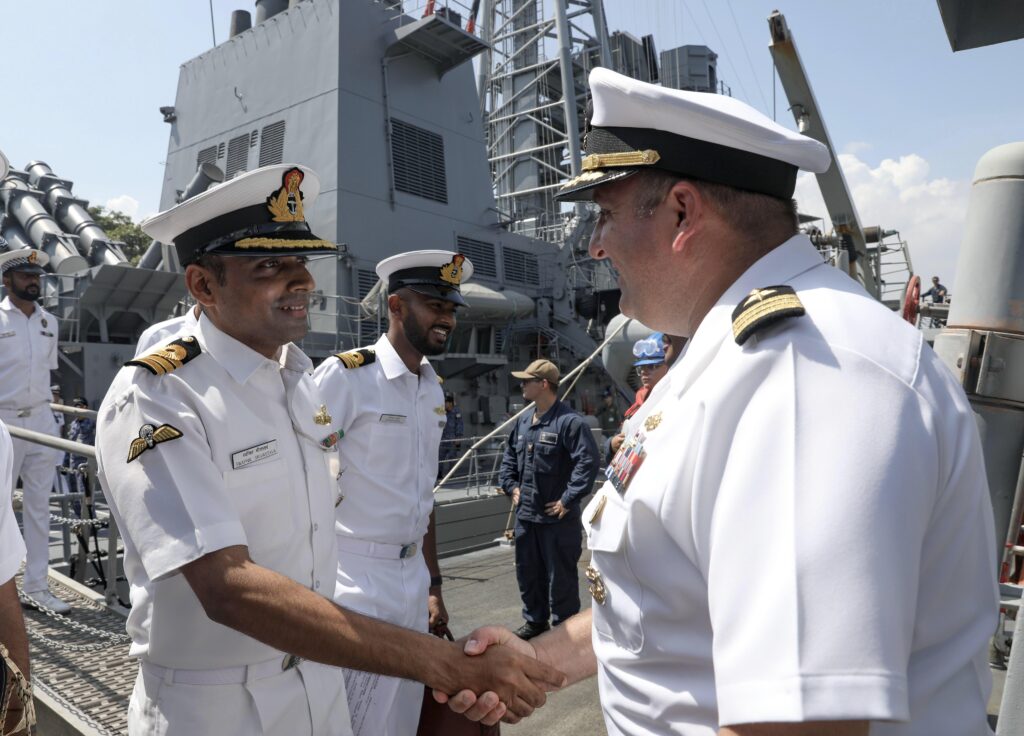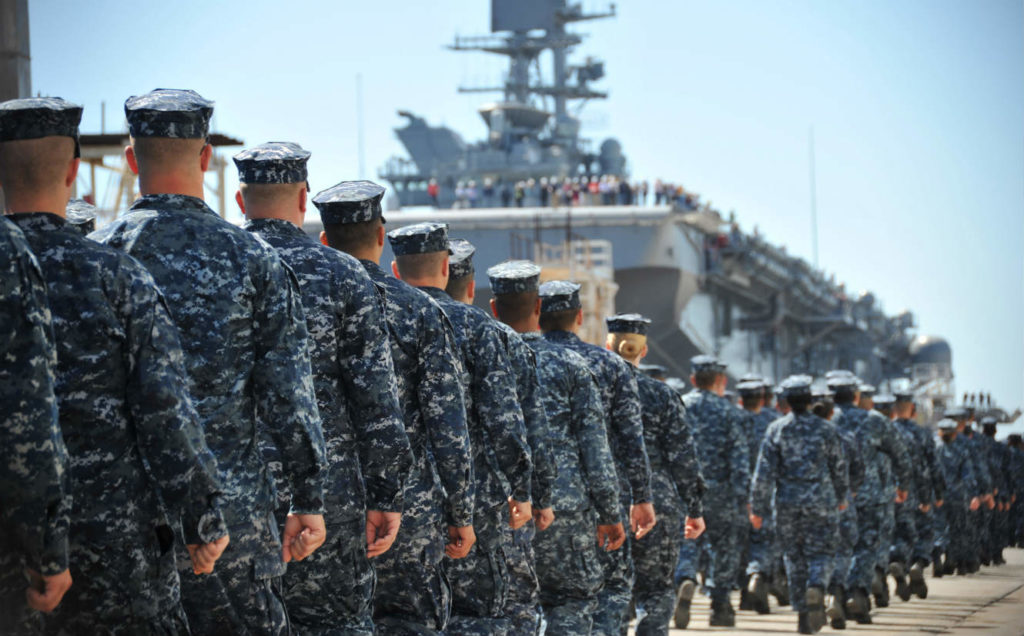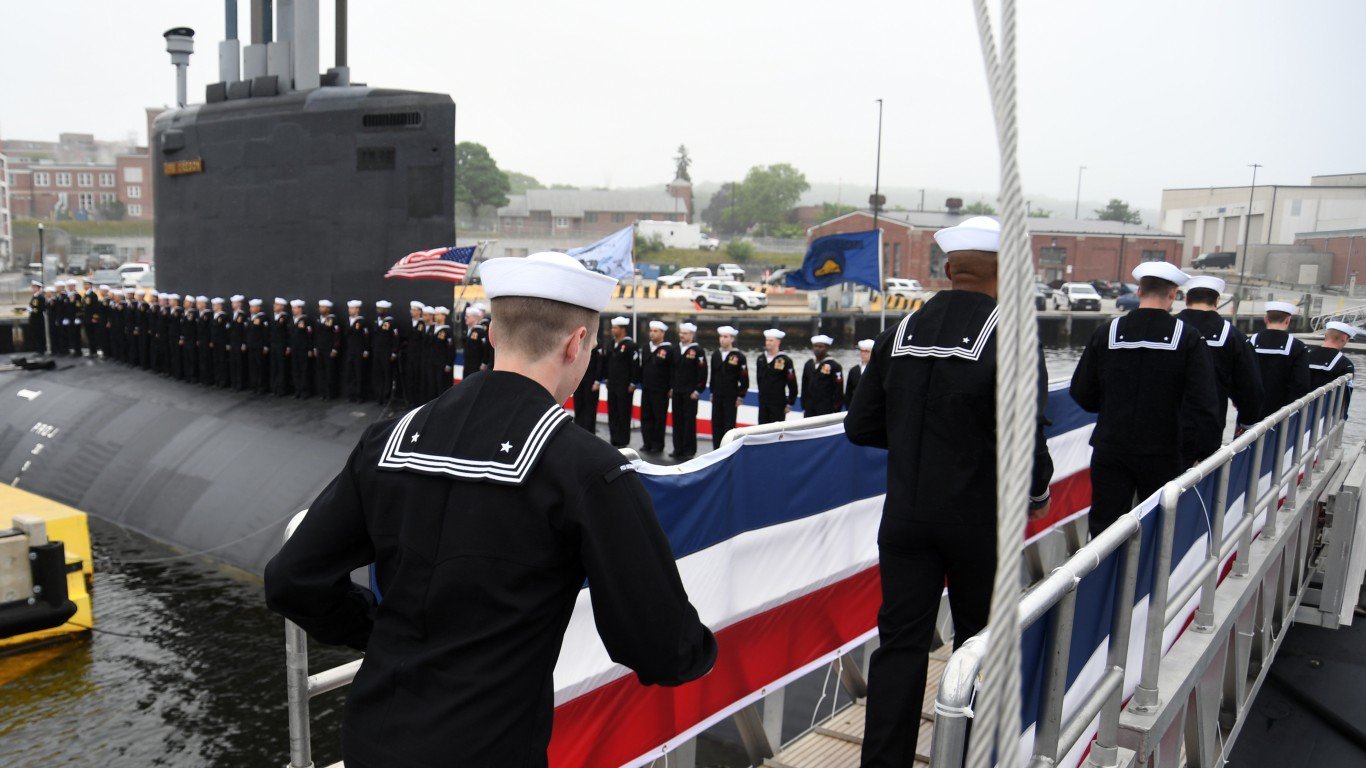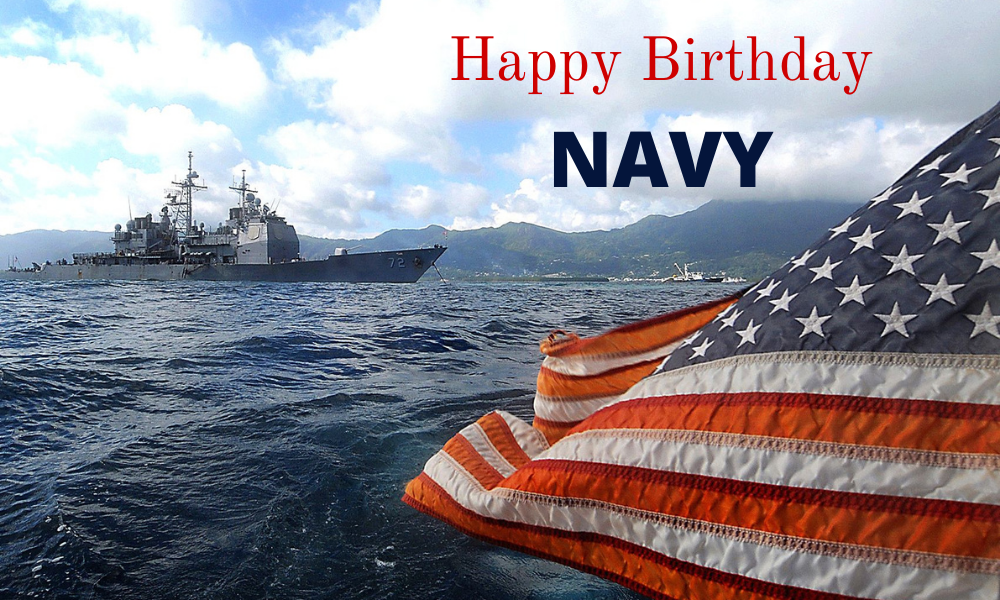On October 13, 2025, we commemorate the 250th birthday of the United States Navy. Since its establishment on October 13, 1775, the Navy has played a critical role in safeguarding the United States. For nearly two and a half centuries, the Navy has stood ready to defend our interests and uphold international maritime freedom.

The History of the U.S. Navy
The U.S. Navy was established on October 13, 1775, during the American Revolution, when the Continental Congress authorized a small naval force to disrupt British supply lines and challenge their sea power. Comprised of a modest fleet of ships working alongside privateers, the early Navy engaged in tactical raids using converted frigates and schooners. These operations played a vital role in weakening British forces and protecting American interests at sea, proving the strategic value of naval warfare.

After the Revolution, the Navy was disbanded due to financial constraints, but the rise of global trade and foreign threats led Congress to reestablish it in 1794. With the construction of a new fleet of frigates, including the iconic USS Constitution, the U.S. Navy became a permanent fixture in American defense, laying the foundation for its future as a global naval power.
Notable Firsts in U.S. Navy History
Throughout its 250-year history, the Navy has achieved many firsts that shaped its growth and technological advancement:
- First Submarine: The Navy’s first commissioned submarine, the USS Holland, launched in 1898, paving the way for the development of underwater warfare.
- First Modern Battleships: In 1908, the Navy introduced its first modern battleships, starting with the USS Michigan, which reflected the latest innovations in naval warfare.
- First Aircraft Carrier: The Navy’s entry into aviation began with a flight from a U.S. Navy cruiser in 1910, leading to the 1927 introduction of the Lexington-class aircraft carriers, the first operational carriers in Navy history.
- First Use of Guided Missiles: In the post-World War II era, the U.S. Navy pioneered the use of guided missiles on its destroyers and cruisers, revolutionizing naval warfare and enabling precision strikes.

The Role of the Navy in World War II
World War II marked a defining moment for the U.S. Navy, transforming it into a dominant global force across both the Atlantic and Pacific theaters. The Navy expanded significantly during the war, growing from 790 ships in 1941 to over 6,700 by 1945. Key victories in major naval battles such as the Battle of Midway (June 1942), Leyte Gulf (October 1944), and the Battle of the Atlantic (1939-1945) were instrumental in crippling enemy fleets and securing crucial supply routes for Allied forces.

A pivotal moment came during the Battle of Midway, where the U.S. Navy, using intelligence and carrier-based aircraft, sank four Japanese aircraft carriers, a critical blow that halted Japan’s expansion. By the war’s end, the Navy had deployed 28 aircraft carriers, over 300 submarines, and thousands of warships, establishing its dominance as a key player in both oceanic and air warfare. This projection of air power, especially through carriers like the USS Enterprise and USS Yorktown, allowed the U.S. to engage Japanese forces across vast distances, securing a decisive victory in the Pacific.
The U.S. Navy Today: Humanitarian Efforts
Today, the U.S. Navy is one of the largest and most advanced naval forces in the world, operating with over 290 deployable ships and approximately 3,700 aircraft as of 2025. The Navy’s fleet includes 11 aircraft carriers, which form the backbone of its power projection capabilities, 68 submarines, and numerous destroyers and amphibious assault ships. With a global mission to deter aggression, ensure freedom of navigation, and provide humanitarian assistance, the Navy’s presence spans every major ocean and strategic waterway.

In addition to its combat capabilities, the Navy has a long-standing history of humanitarian efforts. After the 2004 Indian Ocean tsunami, Navy ships, including the USS Abraham Lincoln, were among the first to arrive, providing vital supplies, water, and medical care to those affected. Similarly, during Hurricane Katrina, naval assets such as the USS Iwo Jima were deployed to assist in relief efforts. More recently, during the COVID-19 pandemic, the Navy’s hospital ships, including the USNS Comfort and USNS Mercy, were deployed to major U.S. cities to provide critical medical support to civilian hospitals overwhelmed by the virus. These missions highlight the Navy’s crucial role in both wartime and peacetime operations around the world.

Famous Figures Who Served in the U.S. Navy
Over the years, many public figures have proudly served in the U.S. Navy, later achieving fame in diverse fields such as politics, entertainment, and sports. Their time in the Navy helped shape their character, discipline, and determination, contributing to their success. Here are some of the most notable celebriities who served:
- John F. Kennedy – Before becoming the 35th President of the United States, John F. Kennedy served as a Navy lieutenant during World War II. His leadership and heroism as the commander of the patrol torpedo boat PT-109 during a mission in the Solomon Islands earned him the Navy and Marine Corps Medal. His bravery in rescuing his crew after the boat was struck by a Japanese destroyer became legendary.
- Paul Newman – Iconic actor and philanthropist Paul Newman served in the U.S. Navy as a radioman and rear gunner during World War II. Newman initially trained as a pilot but was reassigned due to his color blindness. His military service included duty in the Pacific theater, where he flew as a crew member in torpedo bombers.
- Bob Barker – Known for hosting The Price is Right for over 35 years, Bob Barker served as a fighter pilot in the U.S. Navy during World War II. He completed his training but the war ended before he was deployed into combat. Barker’s disciplined demeanor and work ethic can be traced back to his military training.
- David Robinson – NBA Hall of Famer David Robinson, known as “The Admiral” due to his Navy service, is a rare example of an elite athlete who balanced military and professional sports careers. Robinson attended the U.S. Naval Academy and served two years of active duty as a civil engineering officer before transitioning to a highly successful career in the NBA, where he became a two-time NBA champion and Olympic gold medalist.
- Jimmy Carter – Long before he became the 39th President of the United States, Jimmy Carter served as a lieutenant in the U.S. Navy from 1946 to 1953. Carter worked under Admiral Hyman Rickover in the Navy’s nuclear submarine program, which profoundly influenced his leadership style and commitment to public service.
- Gene Hackman – The Oscar-winning actor, best known for roles in The French Connection and Unforgiven, enlisted in the U.S. Navy at the age of 16. He served for nearly five years as a radio operator in China, which he later credited as a formative experience that helped him grow into the disciplined and focused performer the world came to know.
- Johnny Carson – Famous for hosting The Tonight Show for 30 years, Johnny Carson served in the U.S. Navy during World War II as a communications officer. He was commissioned as an ensign and served aboard the USS Pennsylvania, providing support during the war in the Pacific.
- Humphrey Bogart – The star of Casablanca and The Maltese Falcon, Humphrey Bogart served in the U.S. Navy during World War I. His experiences as a naval serviceman shaped his tough-guy image, which he later brought to the silver screen.
- Buster Keaton – Known for his groundbreaking work in silent film, Buster Keaton also served in the U.S. Navy during World War I. His experiences in the Navy are said to have influenced his physical comedy, particularly his famous stunts, which required precision and bravery.
- Henry Fonda – Academy Award-winning actor Henry Fonda served as a quartermaster 3rd class in the U.S. Navy during World War II. Fonda enlisted despite his established Hollywood career because he felt compelled to serve his country during a time of need.
- Steve McQueen – Known as “The King of Cool,” Steve McQueen joined the U.S. Navy in 1947 and served as a tank mechanic and part of the Marine Corps Honor Guard. His time in the military shaped his rebellious yet disciplined persona, which later became a hallmark of his acting career in iconic films like The Great Escape and Bullitt.
- Rock Hudson – One of Hollywood’s biggest stars in the 1950s and 1960s, Rock Hudson served in the U.S. Navy during World War II as an aircraft mechanic. His service, which included assignments in the Philippines, provided him with the resilience and work ethic that he carried into his acting career.
These famous veterans serve as a testament to the Navy’s impact on individuals from all walks of life, showing how military service can shape character, build resilience, and inspire greatness.
Fascinating Facts About the U.S. Navy
Here are some lesser-known facts about the U.S. Navy:
- Largest Navy in the World: The U.S. Navy is not only the largest navy in terms of ships and personnel, but it also operates more aircraft than any other country’s air force except the U.S. Air Force.
- Navy SEALs: The Navy is home to one of the most elite special operations forces in the world, the Navy SEALs. Established in 1962, SEAL teams have conducted high-profile missions, including the raid that killed Osama bin Laden in 2011.
- Oldest Active Ship: The USS Constitution, also known as “Old Ironsides,” is the oldest commissioned warship still afloat. Launched in 1797, it remains a symbol of the Navy’s enduring legacy.
- The Blue Angels: The U.S. Navy’s flight demonstration team, the Blue Angels, was formed in 1946 and continues to perform thrilling aerial shows worldwide, showcasing the precision and skill of naval aviators.

Celebrating the 250th Birthday of the U.S. Navy
In 2025, the U.S. Navy will celebrate its 250th birthday with a series of flagship events centered in Philadelphia, Pennsylvania, the birthplace of the Navy. The celebrations will feature a wide range of activities for both the public and the Navy community.
On October 10–12, the Navy will host the Parade of Ships on the Delaware River, including historic vessels such as the USS Olympia, the USS New Jersey and a replica of the USS Providence. Public ship tours and waterfront activities will allow visitors to connect with the Navy’s heritage up close.
The festivities will also include a flag-raising ceremony, birthday parade, Navy Band concerts, aviation flyovers and community outreach events across the city. Families can explore historical exhibits, static military displays and walking tours that showcase 250 years of naval history and innovation.
A highlight of the anniversary will be the 250th Navy Birthday Gala on October 11, 2025, at the National Constitution Center, honoring past and present sailors while commemorating the Navy’s legacy of service.
Honoring 250 Years of U.S.Navy
As we celebrate the 250th birthday of the U.S. Navy, we pay tribute to the sailors, both past and present, who have dedicated their lives to defending the nation. Their service and sacrifice have helped ensure the Navy’s continued success as a force for peace and stability across the globe.

Read About Other Military Stories
If you enjoyed learning about the significant role and rich history of the U.S. Navy, we invite you to read the stories of other remarkable soldiers and their heroic deeds on our blog. In addition to our profiles of celebrities who served, we share military book reviews, veterans’ service reflections, famous military units and more on the TogetherWeServed.com blog. If you are a veteran, find your military buddies, view historic boot camp photos, build a printable military service plaque, and more on TogetherWeServed.com today.

With all due respect to our fellow brethren in the U. S. Navy,Gene Hackman joined the U. S. Marine Corps (USMC), a military service which is a subsidiary of the Department of the Navy, as is the U. S. Navy (USN). We U.S. Marines are proud partners of America’s “Naval Team”. Although all military services enjoying deriding our fellow services in jest, deep down the USN and USMC are philosophically and symbiotically tied to one another.
Generically marines evolved 2500 years ago as “soldiers from the sea”. The primary individual mission was of marines was to perform those tasks aboard war ships that did not directly involve the physical performance of the ship as a naval vessel. These initial tasks were to serve as “naval infantry”, which primarily was as the “boarding parties” of adjacent enemy vessels. Through the years this initial mission evolved to include serving as the ship commander’s personal guard. As warships’ primary means of offense evolved from individual physical assault (closing with and boarding enemy ships) to the use of naval guns, marines help man the guns during naval battles. As warships’ primary means of propulsion evolved from man-power (oarsmen) to wind (sails) to internal combustion (oil), our Navy needed to have secure fueling stations far from the mainland. U.S. Marines, as members of the Naval service, became the advance party securing those distant fueling points.
The U. S. Marine Corps (USMC) has evolved from those initial missions to the fighting force it is today and it primarily attacks from the sea. The USMC must have the USN and our partnership forms the maritime defense arm of our nation,but we are Marines not Sailors.
Gene Hackman joined the USMC, not the USN. He was and is a U.S. Marine.
s/f
m
As was Steve McQueen.
Go navy. Beat army